|
FEATURE
The Plague: Could It Happen Again?
Megan Sever
Graver threats
Plague
through the ages Print Exclusive
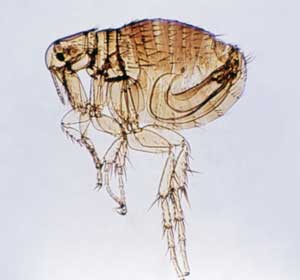 |
| Humans can contract bubonic plague when bitten by a flea that is carrying the plague bacterium, Yersinia pestis, or by handling an infected animal. Photograph is courtesy of CDC. |
Plague ravaged Europe for nearly 500 years, brought about by the expansion of global travel at the same time climate changed, according to new research. Given the extent of globalization today, when a person can fly anywhere in the world in a day or two, and the fact that the climate is changing, health officials and the public wonder if there is a risk of history repeating itself.
The 14th through 19th centuries were challenging times in Europe. Winters were harsh, filled with heavy snowfalls that lasted late into spring and ice that perpetually covered mountaintops and pushed into settled valleys. Springs and summers were so cold and wet that crops would not grow, or became moldy before they could be consumed. People and livestock starved. Wars were fought over scant resources as people traveled farther than before, searching for food and better conditions and colliding with anyone who got in their way.
These desolate conditions forced people to leave their homes and rotting fields in the countryside and head for cities, where crowding and poor sanitation were the rule. Meanwhile, international trade greatly expanded, as ships and caravans brought goods from Asia into European cities. Trade brought more than just goods, however: It also brought diseases.
During these 500 years of cold, extreme and unpredictable weather in Europe, temperatures rose slightly for brief periods of time. But rather than providing a respite from the cold, the warmer temperatures actually promoted the proliferation of infectious diseases. Chief among them was plague. Estimates suggest that up to half of Europe’s already weakened population was wiped out by devastating epidemics, including the infamous Black Death that began in 1347 and the Great Plague of London in 1665, when people died so quickly that bodies piled up on the sidewalks.
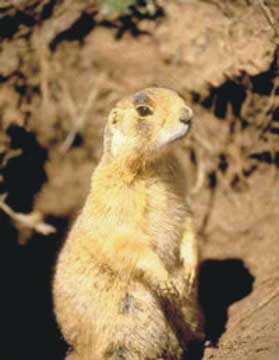 |
| In the American Southwest, prairie dogs are often carriers of the plague bacterium. In Europe, black rats and Norway rats (pictured below) are carriers of bubonic plague bacterium. These rats are very common in cities, and are widely blamed for the European plague epidemics in the Middle Ages. Photographs are courtesy of CDC. |
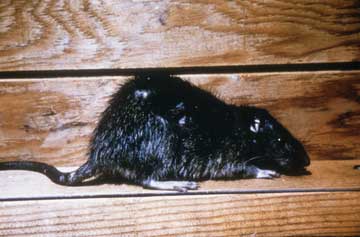 |
With today’s rapid global transport, infectious vectors, which are more diverse in many regions than centuries ago, can move much faster. The SARS virus, for example, spread from China to 30 countries around the world, from South Africa to Switzerland, in a matter of weeks to months in 2002 and 2003. And the concern is ever-rising about how quickly and to where avian flu can spread (see story, this issue). Furthermore, with the predicted rising temperatures and changing precipitation patterns, the optimal climate conditions for diseases such as plague can now extend into new locations, intersecting new areas of human populations just as plague did in the 14th century. In Central Asia alone, for example, a 1 degree Celsius rise in spring temperatures can lead to a 59 percent increase in plague prevalence the following summer, according to new research. And considering the panic incited at the very mention of the word, it’s a concern.
Today, geoscientists, climatologists, epidemiologists and entomologists are joining forces to learn more about the plague, to figure out whether we may be set up for the next great plague pandemic, and to limit the impact among humans.
“The Plague”
Colloquially, “plague” refers to a pestilence or a pandemic disease that spreads rapidly between humans, says Kenneth Gage, chief of flea-borne diseases at the Centers for Disease Control (CDC) in Fort Collins, Colo. Clinically, however, “plague” refers to a specific disease circulating primarily among small mammals and their fleas that is caused by a bacterium called Yersinia pestis, he says.
The three versions of the plague depend on how it affects a person: Bubonic plague is the most common form and results in flu-like symptoms and the swelling of lymph nodes in the neck, armpit or groin into large, painful cysts called buboes. Pneumonic plague is the least common but most dangerous form of plague. In this form of pneumonia, plague bacterium gets into the lungs of the victim, causing the coughing up of bloody sputum. Septicaemic plague occurs primarily as a secondary disease, Gage says, when pneumonic or bubonic plague is left untreated and the bacterium gets into the victim’s bloodstream, causing septic shock or other serious problems.
Unless very promptly treated, pneumonic and septicaemic plague are almost always fatal, says David Engelthaler, director of TGen North, a pathogen genomics laboratory in Flagstaff, Ariz., and a branch of the Translational Genomics Research Institute in Phoenix, Ariz. But bubonic plague progresses slower than the other two forms of the disease and is highly treatable with antibiotics if caught early, he says.
Pneumonic plague can be spread from human to human through coughing, but “you need direct, face-to-face contact” for that to happen, Gage says. Even though it is an infectious disease, being in the general vicinity of someone with pneumonic plague is not enough for someone to catch it. Typically, this type of plague is only seen in developing countries such as Ecuador, Uganda and India, and even then only among families living in close quarters, he says. The United States hasn’t seen a case of pneumonic plague spread from one human to another since 1924, he says. Occasionally in the United States, a case pops up where pneumonic plague is spread from a domestic cat to a human, but it’s very rare, he says. Less than 2 percent of annual cases of plague worldwide are pneumonic plague spread from human to human or domestic animal to human, he says.
Bubonic plague is much more common, though it is still a rare disease, Gage says. Worldwide, some 1,000 to 3,000 cases of human infection occur each year, according to the World Health Organization (WHO). Humans can acquire the disease by being bitten by an infectious flea, handling an infected animal or, rarely, inhaling infectious materials, Gage says. Seventy to 80 percent of human plague cases worldwide each year are acquired by flea bites, he says. Around 20 percent of cases are caused by handling infected animals. Occasionally, so-called human fleas, Pulex irritans, can become carriers of the bacterium and can thus transmit it to humans, Engelthaler says, which may have been the cause of the great pandemics of the past. Now, he says, that situation is extremely rare, thanks to modern sanitation.
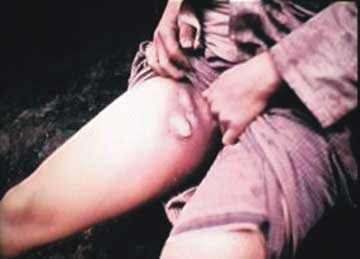 |
| Buboes, or swollen lymph nodes, are classic signs of bubonic plague. Buboes appear in the lymph nodes closest to where a flea bit a person. Photograph is courtesy of CDC. |
Today, plague still exists in many African countries, East and Central Asia and the Americas. The overwhelming majority of outbreaks occur in Africa, especially in Madagascar, according to WHO: In 2003, nine countries reported 2,118 cases of plague and 182 deaths from the disease. Of those, 98.7 percent of the cases were in Africa, and 98.9 percent of the deaths occurred in Africa. Still, the disease could spread with climate change both geographically and in prevalence, according to new research.
The environmental link
Bubonic plague is “a disease of nature,” Engelthaler says, meaning that climate and landscape play a vital role in the survival and spread of the bacterium that causes the disease. Rodent and flea population dynamics are driven by many factors, Gage adds, including food availability, disease and climate variables, namely precipitation and temperature. In studies published over the last five years, models and observations have shown that precipitation and temperature strongly influence the spread of plague.
The most important factor in the disease, besides the bacterium, Engelthaler says, is the flea that carries and transmits the disease. Not all species of flea will transfer or maintain the bacterium, and some transmit it better than others. The type of flea that lives on cats, for example, is not a good vector, he says. But the fleas that live on black rats and ground squirrels are great vectors. Furthermore, the fleas that carry Yersinia pestis can only survive for long periods in “optimal” conditions, including warm but not hot temperatures and wet environments. And they can only transmit the bacterium under even more specific conditions, he says. If temperatures get too hot, the biology of the bacterium stops it from spreading, by breaking down the bacterial blockages that have built up in the flea vector’s gut and are considered essential for efficient transmission.
In addition to needing the right type of flea, the right type of host needs to be present to keep the cycle of transfer from flea to host and back to flea going, Engelthaler says. Black rats and prairie dogs die within days of being infected, so they might not be the best hosts, he says. Although ground squirrels also often die from plague, they can carry the bacterium around for months, allowing fleas to transfer the plague bacterium from their dying host to another unsuspecting host.
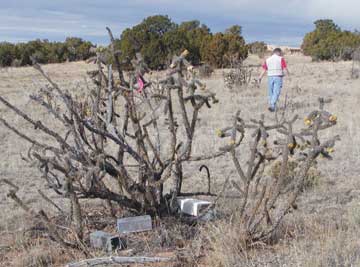 |
| Researchers in the American Southwest trap rodents and then test them for the plague bacterium, Yersinia pestis. New research in the Southwest is suggesting that increasing rainfall in late winter and early spring, such as often happens during El Niño years, can lead to a sizable increase in plague incidences 15 months later. Photograph is courtesy of Ken Gage. |
To get widespread epidemics of the disease, the density of host rodents must first reach a threshold level in a region, Gage says. Then the weather has to cooperate to keep it going and to increase the number of human cases, he says.
In the American Southwest, where plague is prevalent in wild rodents and an average of five to 15 people contract the disease each year, increasing rainfall in late winter and early spring leads to a sizable increase in plague 15 months later, Gage says, as seen in models and observations over the past 50 years. It works in a sort of “trophic cascade,” he says: “Heavy precipitation in early spring leads to more plant growth and more insects, which means more food for the rodents, which leads to more hosts for the [plague-bearing] fleas, and thus more plague.” The other important factor, he says, is lower summer temperatures.
The story is similar in Central Asia, says Nils Chr. Stenseth of the University of Oslo. Infection rates and climate data from 1949 to 1995 in Kazakhstan showed that with just a 1 degree Celsius increase in spring temperatures, plague prevalence in gerbils more than doubled a year or two later, Stenseth says. Wetter summers also led to an increase in plague prevalence the following fall, he says.
Ongoing research in China and other parts of the world is finding a similar trend, Stenseth says, though the exact mechanisms may be slightly different, such as whether spring or summer precipitation or temperature is the driving factor. And models are agreeing with the data. “The general message we’re seeing all over the world is that climate is important,” he says. “Furthermore, climate is changing in a way that will affect human plague cases.”
The future
“You can make four generalities about climate change’s effects on biodiversity,” including everything from pathogens to fleas, rodents to humans, says Townsend Peterson of the University of Kansas. First, when temperatures rise, species’ distributions tend to shift toward poles. Secondly, species’ distributions tend to shift upward in elevation. Third, “complex topography makes for smaller-scale, less dramatic effects: For example, you’ll see more dramatic shifts in the Great Plains, which are flatter, than in the Rockies,” he says. “And finally, the kicker is that every species is an individual and it’s pretty darn hard to predict what they are going to do as the climate changes,” he says.
Nonetheless, Peterson says, “the link between plague and climate change opens all sorts of doors and prompts all sorts of questions.” The two primary questions for the future, he says, are whether or not the disease’s range will spread or migrate, and if its prevalence will increase.
Peterson and colleagues modeled these possible changes for plague and tularemia in the United States in coming decades. Using several different climate models, including the Hadley Centre and the Canadian models, and running models for both extreme-case scenarios of extensive climate change and minimal climate change, the team found that plague will not likely shift its range extensively in North America, although tularemia will likely shift somewhat northward. Plague is likely not showing dramatic geographic shifts in the American Southwest because of the complex topography.
That doesn’t speak to prevalence, however. Climate models suggest that the Southwest may see more varied weather patterns, such as more El Niño years. And El Niño years bring the precise cooler, wetter temperatures to the region that the plague loves, Gage says. The strong El Niño in 1982 was followed by a two-year spike in human plague cases, he says. Tularemia and hantavirus pulmonary syndrome (spread by field mice) cases have also spiked in the wake of El Niño events, Peterson adds. “We saw the same thing happen after the 1992 El Niño,” Gage says. First, a hantavirus outbreak erupted in 1993 and then plague cases spiked the following year. Human plague cases then decreased drastically in the summer of 1994, he says, likely because the summer was “incredibly hot with 100-degree-Fahrenheit-plus temperatures.” That likely killed off the fleas, he says.
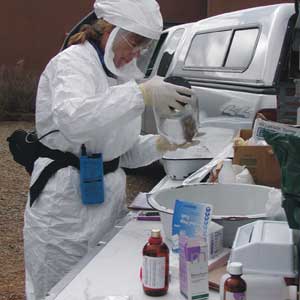 |
| Researchers in the American Southwest test fleas for the plague bacterium. Photograph is courtesy of Ken Gage. |
In Central Asia, climate models suggest that the precise weather conditions conducive to plague — warmer and wetter springs and summers — will grow more frequent in coming decades, Stenseth says. Those conditions would lead to an increase in rodent populations and thus an increase in plague, he says.
Pandemics
“I fully expect we will see an increase in the number of humans affected by plague” in coming decades, Stenseth says. “But there’s no reason to suggest we will see another Black Death.”
Indeed, climatic changes could very easily lead to an increase in conditions conducive to rodent (host) population expansion and more human plague cases in some areas, Gage says. Furthermore, humans, and Americans especially, are moving farther and farther out of cities and into suburbs and rural areas where they are more likely to encounter plague-ridden rodents. But climatic changes could also cause a decrease in human plague cases in other regions, he says, such as the American Southwest, if it gets too hot and dry.
The research linking climate change and plague is “really early in the process and there is a lot more to be done,” Peterson adds. “But what I can say is that the likelihood of a pandemic” of bubonic plague “is incredibly slim,” as most people don’t live on top of one another in squalor and surrounded by rats like they used to, and modern healthcare can cure the disease once it strikes, he says.
Still, questions remain. Overall, whether or not more people will get the plague is “just really hard to predict,” Gage says. Although temperatures were much colder in Europe during the Little Ice Age (roughly 1300 to 1850), those brief periods of warming around the mid-1300s, mid-1600s and mid-1800s, as recorded in tree-rings, occurred at the same time as the plague pandemics, Stenseth says. The Black Death struck Europe in 1347. The Great Plague of London struck in 1665. The Third Pandemic began around 1855 in China.
Overall, so many factors are involved in the rise and spread of bubonic plague that causation between climate and the disease is not conclusive, Stenseth says, but it’s certainly a possibility.
|
With warming temperatures and changes in precipitation patterns come changing threats to human health. Recent research linking historic outbreaks of bubonic plague to climate change have led some people to wonder if another plague pandemic is on the horizon. But climate and health researchers say that a resurgent bubonic plague is probably the least of our worries. Malaria. Dengue fever. Filariasis. Giardia. Cryptosporidiosis. West Nile virus. Avian Flu. Giardia. Hantavirus pulmonary syndrome. Bubonic plague. These, among other, vector-borne and waterborne diseases are “highly sensitive to climate,” says Jonathan Patz, an associate professor of Environmental Studies and Population Health Sciences at the University of Wisconsin-Madison. Some of these diseases are more affected by temperatures and others by precipitation changes, Patz says. Cryptosporidiosis and giardia outbreaks, for example, can be tied directly to extremes in the hydrologic cycle, he says. In 1993, following the heaviest rainfall in the previous 50 years, a cryptosporidiosis outbreak struck Milwaukee, Wis., sickening 400,000 people through drinking water. Hantavirus and plague are also tied to hydrologic extremes, such as strong El Niños (see main story). In recent years, the geographic extents of outbreaks of West Nile, malaria and dengue fever have expanded, thanks to warming temperatures, Patz says. Further warming may exacerbate the situation, sending malaria back into Europe, where it hasn’t been common for centuries (see Geotimes, May 2005). Still another human health challenge may arise from rising sea levels, Patz says. In developing countries, as people migrate inland to escape rising sea levels and storms, they may be exposed to new diseases, or they may end up living in poor, crowded shelters with little healthcare — similar to the type of unsanitary conditions Europeans faced in the Middle Ages when the plague ravaged the populations. This “is a very difficult risk to study, but it could be the biggest problem, the large mass under the tip of the iceberg,” Patz says. The risks human face most directly from climate changes, however, Patz says, are extremes such as heat waves like the one that struck Europe in 2003 and killed thousands of people. Regardless of the exact form the threats will take, warmer temperatures and wetter weather influence infectious diseases, according to the World Health Organization (WHO). And though it is quite difficult to quantify disease changes, “changes in infectious disease transmission patterns are a likely major consequence” of such climate changes, according to WHO. |
Links:
"On the Path of Bird Flu," Geotimes, May 2007
"Malaria Mapping and Prevention," Geotimes, May 2005

 Subscribe
Subscribe


